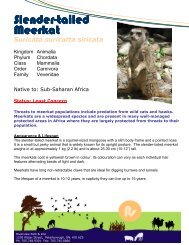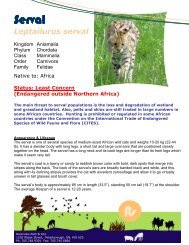Bobcat - Peterborough Utilities
Bobcat - Peterborough Utilities
Bobcat - Peterborough Utilities
Create successful ePaper yourself
Turn your PDF publications into a flip-book with our unique Google optimized e-Paper software.
<strong>Bobcat</strong><br />
<strong>Bobcat</strong><br />
Lynx rufus<br />
Kingdom Animalia<br />
Phylum Chordata<br />
Class Mammalia<br />
Order Carnivora<br />
Family Felidae<br />
Native to: North America, Southern Canada down to Mexico.<br />
Status: Least Concern<br />
In Mexico, bobcats are persecuted as sheep predators and are frequently killed<br />
by farmers. They are still hunted and trapped for their fur throughout most of<br />
their range. Habitat destruction and the ever-expanding human population<br />
limit their ranges. Habitat loss is viewed as the primary threat to bobcats in all<br />
three range countries.<br />
Appearance & Lifespan<br />
The bobcat has a gray to brown coat, whiskered face, and black-tufted ears. It has distinctive<br />
black bars on its forelegs and a black-tipped, stubby tail, from which it derives its name. Its<br />
coat is spotted from birth to help camouflage it from predators and prey. This cat has sharp<br />
hearing and vision, and a good sense of smell.<br />
The bobcat is about twice the size of an average house cat. It can be 17-23 inches in height<br />
and 25-41 inches in length. Male bobcats usually weigh 16-28 lbs. and females 10-18 abs.<br />
The lifespan of a bobcat is about 12-15 years but in the right conditions they can live up to 25<br />
years.<br />
Riverview Park & Zoo<br />
1230 Water Street, <strong>Peterborough</strong>, ON. K9J 6Z5<br />
Ph. 705.748.9301 Fax: 705.745.6866
Behavior & Reproduction<br />
<strong>Bobcat</strong>s are usually solitary and territorial animals, females never share a territory with each other.<br />
Male territories can sometimes overlap. Territory sizes are extremely varied – generally 25-30 square<br />
miles for males and about five square miles for females. <strong>Bobcat</strong>s use several methods to mark their<br />
territorial boundaries, including claw marks and deposits of urine or feces.<br />
<strong>Bobcat</strong>s like to live in dens, they may have one main den and several other small dens in their<br />
territory. The main den is usually a cave or rock shelter but could also be under a fallen tree<br />
as long as it is a protected place, the other dens are used for shelter while hunting in areas<br />
farther away from the main den.<br />
Mating season for the bobcat is usually late winter but anytime during the year is possible. In<br />
the spring females usually give birth to 1-6 kittens after a gestation period of 50-70 days. The<br />
kittens begin eating solid food at around two months of age and begin learning to hunt with<br />
their mother when they are 5 months old. When they are between 8 and 11 months, the<br />
kittens are evicted from their mother's territory and must find their own.<br />
Ecology & Habitat<br />
<strong>Bobcat</strong>s are found in wooded areas, brush land, semi-deserts, mountainous areas, forest edges and<br />
swampland environments. A habitat dense with vegetation and lots of prey is ideal. <strong>Bobcat</strong>s are<br />
excellent hunters, stalking prey with stealth and patience, then capturing their meals with one great<br />
leap.<br />
Favorite foods for the bobcat are rabbit and hares but they will also eat rodents, birds, bats, and even<br />
deer.<br />
At the zoo our bobcat eats horse meat mixed with beef organs, beef bones and pork hocks.<br />
Did You Know?<br />
1. <strong>Bobcat</strong> eyes are yellow with black pupils.<br />
2. <strong>Bobcat</strong>s are excellent climbers, and will swim when they need to, but will normally avoid water.<br />
3. It is common for a bobcat to walk 4 miles in a day.<br />
Riverview Park & Zoo<br />
1230 Water Street, <strong>Peterborough</strong>, ON. K9J 6Z5<br />
Ph. 705.748.9301 Fax: 705.745.6866





